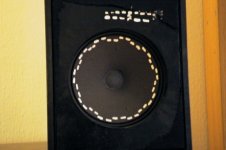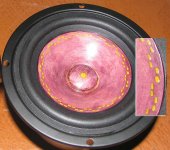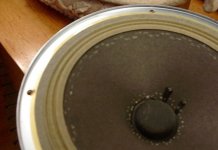Pure businessman response. Whatever expense that can be saved is saved. I think now you can understand why my private suggestion. I do think your patent might be too specific. But if you think you have a case, just wait for a while and see what happens. Lots of things worth doing for large quantity supplies.BudP said:dlr,
...
At one point Dan Wiggins said he intended to provide both an anechoic lab and himself, to explore what is actually going on. However, after emailing me a eureka note from China, concerning using a pattern claimed to be very similar to mine, but left as an unscreened set of extruded blocks on the cone back side, at the main nodal resonance dispersal location, first discovered, or perhaps, first reported by Soonsgc, Dan has stopped answering any of my emails. I can only conjecture what this might mean, but I am assuming testing is no longer on offer.
...
Bud
kaan said:
The thing is that I can't say that there is much difference between the treated and the untreated speaker. Maybe a tiny, tiny bit and that wouldn't be for the better.
Are you surprised? I wasn't.
soongsc said:
The dimensions of the pattern and spacing between the rectangles are not nearly as specified. Spacing between the rectangles are important! Slightly wider spacing might be better than too close.
Typical. kaan did it wrong too. Maybe he should have used toothpaste...
soongsc said:
Could you show some so called cascade plots within the first 0.4ms range or so or whatever the smallest range you can get?
I don't do plots, soongsc, ... I was referring to the ones somewhere way back on this thread. Pretty coloured hills, that were the merest smidgeon shorter on the enabl'd plots.
I meant CSD plots (how switched on am I?)
There's some at 2.3ms in the Replikon link I included a few posts above. Looking at these - would a 0.4ms plot really help us?
Alan
At least you can reuse it for your teeth if you want to.😀MJL21193 said:
Are you surprised? I wasn't.
Typical. kaan did it wrong too. Maybe he should have used toothpaste...
Using this is only the real basic stage. More precise work should be done with somthing better.
0.38ms is the range that I use to identify changes. I do realize that some tools such as CLIO has some diffifulties with this.Alan Hope said:
I don't do plots, soongsc, ... I was referring to the ones somewhere way back on this thread. Pretty coloured hills, that were the merest smidgeon shorter on the enabl'd plots.
I meant CSD plots (how switched on am I?)
There's some at 2.3ms in the Replikon link I included a few posts above. Looking at these - would a 0.4ms plot really help us?
Alan
Hi kaan,
Please take a look here
http://picasaweb.google.com/home?tab=mq there are a number of examples that allow you to see what an EnABL pattern consists of, for a simple cone. Note that there are the same number of block sets for each ring, except at the very center of the voice coil dust cover.
As with John's expression of disappointment at no appreciable change, your mismatch in number of blocks has not aided in suppressing the non signal generated ringing, that EnABL is set up for. With vastly fewer and greater numbers of blocks, you do move out of the "tuned" portion of whatever physical phenomena EnABL is utilizing, to perform it's beneficial work. This with regards to Alan Hope's comments upon elimination of low level fricative hash. I do not know of a better way to describe what disappears when you apply the patterns as specified.
I am sorry that you and John (MJL21193) did not consult with me before you "lit out on your own". However, I fully support your initiative and your courage in doing so. If you want to try it again, on another cheap set of speakers, please provide me with an angled picture of the surface to treat and I will "photoshop" a set of pattern block locations for you, just as I have for other folks.
Just to help in both of your thought processes, this is not a mass damping process. When done properly there just is not enough mass. It does seem to be a surface damping process or in my mind a surface decoupling process. But that is the nut of the current arguing.
So, the patterns do require precision in numbers of "spots", allow some flexibility in individual block length, within the 2 degree arc they are applied to, and some degree of irregularity in "shape". You have just pushed those boundaries too far. Take a close look at the Fostex 127 E photos, to see just how badly my hand shakes when applying these rather small shapes. And this with the flow control provided by using a calligraphy pen, with a 1000 years of development behind it's design. This amount of irregularity is fine, more will be a problem. I have not explored the limits of just how much more is tolerable, so both of you have provided information I did not have and I thank you both for reporting back what you have found.
Bud
Please take a look here
http://picasaweb.google.com/home?tab=mq there are a number of examples that allow you to see what an EnABL pattern consists of, for a simple cone. Note that there are the same number of block sets for each ring, except at the very center of the voice coil dust cover.
As with John's expression of disappointment at no appreciable change, your mismatch in number of blocks has not aided in suppressing the non signal generated ringing, that EnABL is set up for. With vastly fewer and greater numbers of blocks, you do move out of the "tuned" portion of whatever physical phenomena EnABL is utilizing, to perform it's beneficial work. This with regards to Alan Hope's comments upon elimination of low level fricative hash. I do not know of a better way to describe what disappears when you apply the patterns as specified.
I am sorry that you and John (MJL21193) did not consult with me before you "lit out on your own". However, I fully support your initiative and your courage in doing so. If you want to try it again, on another cheap set of speakers, please provide me with an angled picture of the surface to treat and I will "photoshop" a set of pattern block locations for you, just as I have for other folks.
Just to help in both of your thought processes, this is not a mass damping process. When done properly there just is not enough mass. It does seem to be a surface damping process or in my mind a surface decoupling process. But that is the nut of the current arguing.
So, the patterns do require precision in numbers of "spots", allow some flexibility in individual block length, within the 2 degree arc they are applied to, and some degree of irregularity in "shape". You have just pushed those boundaries too far. Take a close look at the Fostex 127 E photos, to see just how badly my hand shakes when applying these rather small shapes. And this with the flow control provided by using a calligraphy pen, with a 1000 years of development behind it's design. This amount of irregularity is fine, more will be a problem. I have not explored the limits of just how much more is tolerable, so both of you have provided information I did not have and I thank you both for reporting back what you have found.
Bud
BudP said:suppressing the non signal generated ringing
I feel like I should be wearing my tinfoil hat when reading this thread. Ringing can be generated without the presence of a signal? Through what mechanism?
BudP said:that EnABL is set up for
EnABL is "set up" for an unknown phenomena?
cheers,
AJ
Well ... after listening to well known music in mono I can't say that I hear a significant difference.
I did get the number of blocks wrong though.
Tomorrow I'll get another pair of speakers and try again.
Could you confirm that I at least have the right pattern in regard to proportion of the blocks an the spacing in between? (on the second speaker that is).
Thanks
Klaus Kaan
I did get the number of blocks wrong though.
Tomorrow I'll get another pair of speakers and try again.
Could you confirm that I at least have the right pattern in regard to proportion of the blocks an the spacing in between? (on the second speaker that is).
Thanks
Klaus Kaan
BudP said:Take a close look at the Fostex 127 E photos, to see just how badly my hand shakes when applying these rather small shapes.
Attached is another example. If yoy count the spots you will see that this 4" driver has the same number of spots and exactly the same arrangement as the picture of the 8" B200 posted earlier (ignoring the extra detail required by the phase plug installation)
Note: the pre-coat on these has nothing to do with EnABL (his wife wanted them marroon
dave
Attachments
Note: the pre-coat on these has nothing to do with EnABL (his wife wanted them marroon
I pity the poor man 😀
kaan said:
Could you confirm that I at least have the right pattern in regard to proportion of the blocks an the spacing in between?
The pattern will only be correct when you hear an improvement.
No improvement = wrong block size, wrong spacing, wrong number of blocks, wrong colour, wrong time of the month, etc.
No improvement = wrong block size, wrong spacing, wrong number of blocks, wrong colour, wrong time of the month, etc.
This from somebody who knows how to do it wrong...😀
Hi John,
Not yet. I have the link saved and intend to do so. Thanks for pointing it out. After doing so myself I wonder about subjecting a diy get-together with the exercise on the EnABL mules...should be interesting.
Not yet. I have the link saved and intend to do so. Thanks for pointing it out. After doing so myself I wonder about subjecting a diy get-together with the exercise on the EnABL mules...should be interesting.
Pinky purple is as pinky purple does.....
Kaan. The relationship of blocks to open space is as follows.
Take any round and divide it up into 36 sectors, of 10 degree's of arc. In each sector there will be two blocks that take up four degrees each, spaced by a two degree opening. Each block is also two degrees thick.
Then offset alternate block sets by the linear distance the width this two degree opening creates. This means leaving a two degree long distance between the top of the lower ring sets and the bottom of the upper ring sets. This means that the total linear distance covered, up the cone, is six degrees of width.
I posted a PDF of this pattern and dimensions here,
http://www.diyaudio.com/forums/showthread.php?postid=1376827#post1376827
Please download it to releave any confusion my words have generated.
AJ
How many books has your AVATAR typed to date?
C2C thomas wears his tin foil hat all of the time, nowadays. I noticed he began doing this after having received a number of my private emails. I always feel pride in my performance when the tin hats must be worn just to keep the ringing in after my signal has passed through.
Bud
Kaan. The relationship of blocks to open space is as follows.
Take any round and divide it up into 36 sectors, of 10 degree's of arc. In each sector there will be two blocks that take up four degrees each, spaced by a two degree opening. Each block is also two degrees thick.
Then offset alternate block sets by the linear distance the width this two degree opening creates. This means leaving a two degree long distance between the top of the lower ring sets and the bottom of the upper ring sets. This means that the total linear distance covered, up the cone, is six degrees of width.
I posted a PDF of this pattern and dimensions here,
http://www.diyaudio.com/forums/showthread.php?postid=1376827#post1376827
Please download it to releave any confusion my words have generated.
AJ
How many books has your AVATAR typed to date?
Sorry, ringing caused by a signal passing through and then having left. But the ringing continues.I feel like I should be wearing my tinfoil hat when reading this thread. Ringing can be generated without the presence of a signal? Through what mechanism?;
C2C thomas wears his tin foil hat all of the time, nowadays. I noticed he began doing this after having received a number of my private emails. I always feel pride in my performance when the tin hats must be worn just to keep the ringing in after my signal has passed through.
Bud
Ed LaFontaine said:Hi John,
Not yet. I have the link saved and intend to do so.
What's the hold up? I thought you guys would jump on the opportunity to demonstrate the improvement this process makes by distinguishing distortion to a lower level.
I'm very disappointed...
BTW, how did I do mine wrong? The blocks aren't yellow, I know.
Attachments
I took it. scored -39. I'll never need to listen to Tracy Chapman again.
John, Maybe you don't know this, but I'm pretty sure the color of the blocks isn't important, but maybe I missed your point.
John, Maybe you don't know this, but I'm pretty sure the color of the blocks isn't important, but maybe I missed your point.
MJL21193 said:
What's the hold up? I thought you guys would jump on the opportunity to demonstrate the improvement this process makes by distinguishing distortion to a lower level.
I'm very disappointed...
BTW, how did I do mine wrong? The blocks aren't yellow, I know.
staggerlee said:I took it. scored -39.
Hi,
When did you take it? You have a screen shot?
The yellow colour thing is what they term a sense of humour thing, you know?
BudP said:Hi kaan,
As with John's expression of disappointment at no appreciable change, your mismatch in number of blocks has not aided in suppressing the non signal generated ringing, that EnABL is set up for. /B]
So you're quite sure in now saying that EnABLE is specifically designed to eliminate distortion, because that IS what non-signal generating ringing is. I find it very curious that you now say it eliminates what, in earlier posts, was not measurable. Yet when it was suggested that a set of distortion measurements be made that would specifically address this aspect, it was dismissed and still seems to be largely ignored. Until your statement now, of course. Now it's the centerpiece of the intention of the application.
All this detail and essentially no measurements. Very bold claim. Simply astounding, actually. Please excuse my incredulity.
Since you say that distortion is explicitly what "EnABL is set up for", which distortion is it supposed to be suppressing? Intermodulation distortion? Non-linear motor distortion?
Whatever EnABLE is doing, it is not "suppressing the non-signal generated ringing". Anyone with any understanding of distortion in drivers will recognize this. There's every possibility that it increases distortion in some area. Only measurements can provide the necessary evidence one way or the other. But the latter is possible, measurement systems have had this capability for many years.
When you start to try to be specific about exactly what is happening without actually understanding the actual impact, credibility declines dramatically. What you just stated above is near total nonsense. EnABLE may alter the linearity of the driver resonances (however one may want to try to describe the mechanism) and/or dampen them, it may alter the distortion profile in some way due to this change in the frequency response, but it is not going to suppress, other than nominally if it does at all, the inherent intermodulation distortion, especially in full-range drivers. It will not be eliminated regardless of any efforts. The motor non-linear distortion, present in all drivers, may likewise show a change in profile, but it is not going to do much to suppress it, either, especially since it's so highly non-linear being directly related to displacement. It's entirely possible that any or all distortion might be made worse. You can't guarantee any specific improvements to any specific driver in this regard. You also can't guarantee that the distortion won't be worse.
Dave
- Status
- Not open for further replies.
- Home
- Loudspeakers
- Multi-Way
- EnABL Processes


